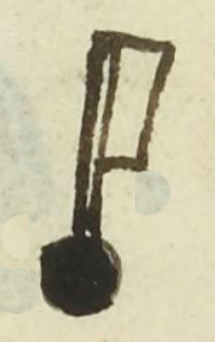Paol (MH661v)
This black-line drawing of the complex glyph for the personal name Paol (perhaps “Rubber Dye”) is attested here as a man’s name. It shows an upright, rectangular, white banner (panitl) on a staff, which has the phonetic role of bringing forth the verb “pa” (to dye). The black-filed circle stands for rubber (olli), whose stem is -ol, the second part of the name.
Stephanie Wood
It is not clear if the translation "Rubber Dye" should be so literal. Perhaps this is a phonetic compound that intends a completely different reading/meaning. For instance, the black ball could translate tapayolli, and the name might be Payol rather than Paol. The "y" before "o" will disappear in some case where the suffix -yotl is meant. Another possibility is that the name is Panol, perhaps "Flag of Rubber" or "Crossing"?
Stephanie Wood
juao. paol.
Juan Paol
Stephanie Wood
1560
Jeff Haskett-Wood
teñir, hule, nombres de hombres

pa, to dye, https://nahuatl.wired-humanities.org/content/pa-1
ol(li), rubber, https://nahuatl.wired-humanities.org/content/olli
tapayol(li), a ball, https://nahuatl.wired-humanities.org/content/tapayolli
panoliz(tli), a crossing, https://nahuatl.wired-humanities.org/content/panoliztli
pano, to cross, https://nahuatl.wired-humanities.org/content/pano
Teñir Hule (?)
Stephanie Wood
Matrícula de Huexotzinco, folio 661v, World Digital Library, https://www.loc.gov/resource/gdcwdl.wdl_15282/?sp=403&st=image
This manuscript is hosted by the Library of Congress and the World Digital Library; used here with the Creative Commons, “Attribution-NonCommercial-ShareAlike 3.0 License” (CC-BY-NC-SAq 3.0).






